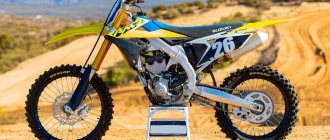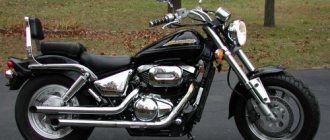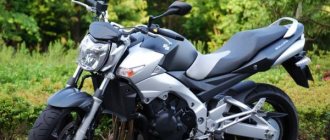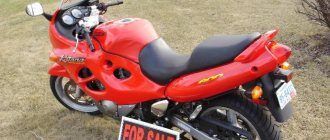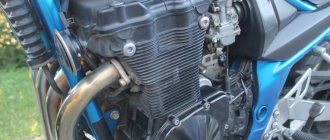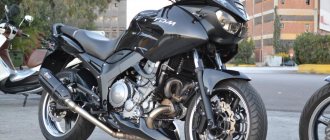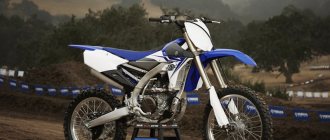| Suzuki RM125 (1984-1985) | Suzuki RM125 (1986-1988) | Suzuki RM125 (1989) | Suzuki RM125 (1990-1992) |
| Suzuki RM250 (1986-1988) | Suzuki RM250 (1989-1994) | Suzuki RM250 (1995-1996) | Suzuki RM250 (1997) |
| Suzuki RM125 (1993-1995) | Suzuki RM125 (1996-1997) | Suzuki RM125 (1998) | Suzuki RM125 (1999-2000) |
| Suzuki RM125 (2001) | Suzuki RM125 (2002) | Suzuki RM125 (2003) | Suzuki RM125 (2004) |
| Suzuki RM125 (2005-2006) | Suzuki RM125 (2007-2008) |
Model of motocross motorcycle Suzuki RM 125
was first introduced in 1974, but the models of greatest interest are those starting in 1990, when the model received an inverted fork and became widely available in the markets of North America, Europe and Japan. In subsequent years, the model underwent many changes that affected the engine, intake system, suspension, geometry and chassis. 2008 was the last year of production of the Suzuki RM125, after which the model left the market and was completely replaced by the 4-stroke Suzuki RM-Z250.
The key features of the Suzuki RM 125 include a steel half-duplex frame, a 2-stroke liquid-cooled engine, sports adjustable suspension in the form of an inverted fork at the front and a progressive pendulum with a monoshock absorber at the rear, disc brakes, a 6-speed gearbox, a power valve system, and a fuel tank. for 8 liters and 87 kg of dry weight.
The “older” model is the Suzuki RM 250.
The main competitors of the Suzuki RM 125 in the class:
- Honda CR125R
- Kawasaki KX 125
- Yamaha YZ 125
Brief history of the model
- 1983 - Model
: Suzuki RM125 (North America).
Factory designation:
RM125D.
- 1984 - Model
: Suzuki RM125 (North America).
Factory designation:
RM125E.
- 1985 - Model
: Suzuki RM125 (North America).
Factory designation:
RM125F.
- 1986 - Model
: Suzuki RM125 (North America).
Factory designation:
RM125G.
- 1987 - Model
: Suzuki RM125 (North America).
Factory designation:
RM125H.
- 1988 - Model
: Suzuki RM125 (North America).
Factory designation:
RM125J.
- 1989 - Model
: Suzuki RM125 (North America).
Factory designation:
RM125K.
- 1990 - Model
: Suzuki RM125 (North America, Europe, Japan).
Factory designation:
RM125L.
- 1991 - Model
: Suzuki RM125 (North America, Europe, Japan).
Factory designation:
RM125M.
- 1992 - Model
: Suzuki RM125 (North America, Europe, Japan).
Factory designation:
RM125N.
- 1993 - Model
: Suzuki RM125 (North America, Europe, Japan).
Factory designation:
RM125P.
- 1994 - Model
: Suzuki RM125 (North America, Europe, Japan).
Factory designation:
RM125R.
- 1995 - Model
: Suzuki RM125 (North America, Europe, Japan).
Factory designation:
RM125S.
- 1996 - Model
: Suzuki RM125 (North America, Europe, Japan).
Factory designation:
RM125T.
- 1997 - Model
: Suzuki RM125 (North America, Europe, Japan).
Factory designation:
RM125V.
- 1998 - Model
: Suzuki RM125 (North America, Europe, Japan).
Factory designation:
RM125W.
- 1999 - Model
: Suzuki RM125 (North America, Europe, Japan).
Factory designation:
RM125X.
- 2000 - Model
: Suzuki RM125 (North America, Europe, Japan).
Factory designation:
RM125Y.
- 2001 - Model
: Suzuki RM125 (North America, Europe, Japan).
Factory designation:
RM125K1.
- 2002 - Model
: Suzuki RM125 (North America, Europe, Japan).
Factory designation:
RM125K2.
- 2003 - Model
: Suzuki RM125 (North America, Europe, Japan).
Factory designation:
RM125K3.
- 2004 - Model
: Suzuki RM125 (North America, Europe, Japan).
Factory designation:
RM125K4.
- 2005 - Model
: Suzuki RM125 (North America, Europe, Japan).
Factory designation:
RM125K5.
- 2006 - Model
: Suzuki RM125 (North America, Europe, Japan).
Factory designation:
RM125K6.
- 2007 - Model
: Suzuki RM125 (North America, Europe, Japan).
Factory designation:
RM125K7.
- 2008 - Model
: Suzuki RM125 (North America, Europe, Japan).
Factory designation:
RM125K8.
Specifications
Technical characteristics of Suzuki RM125 (2007, RM125K7):
| Model | Suzuki RM125 |
| Motorcycle type | cross |
| Year of issue | 1976-2008 |
| Frame | steel half-duplex |
| engine's type | 1-cylinder, 2-stroke |
| Working volume | 124 cm³ |
| Bore/Stroke | 54.0 x 54.5 mm |
| Compression ratio | 8.3:1 (with the power valve open); 9.9:1 (with power valve closed) |
| Cooling | liquid |
| Number of valves per cylinder | intake reed valve |
| Fuel supply system | Carburetor, 1x Mikuni TMX38SS |
| Ignition type | CDI |
| Maximum power | 41.0 hp (30.2 kW) at 11500 rpm |
| Maximum torque | 27.1 Nm (2.8 kg*m) at 10500 rpm |
| Clutch | Multi-disc in oil bath, cable drive |
| Transmission | 6-speed |
| type of drive | chain |
| Front tire size | 80/100-21 51M |
| Rear tire size | 100/90-19 57M |
| Front brakes | 1 disc, 250 mm, 2-piston caliper |
| Rear brakes | 1 disc, 240 mm, 1-piston caliper |
| Front suspension | Inverted fork (adjustable), travel - 310 mm |
| Rear suspension | Progressive pendulum with monoshock absorber (adjustable), stroke - 310 mm |
| Motorcycle length | 2145 mm |
| Motorcycle width | 830 mm |
| Motorcycle height | 1275 mm |
| Wheelbase | 1450 mm |
| Seat height | 950 mm |
| Minimum ground clearance (clearance) | 350 mm |
| Acceleration 0-100 km/h (0-60 mph) | |
| Maximum speed | |
| Gas tank capacity | 8.0 l |
| Motorcycle weight (dry) | 87.0 kg |
Key Features
The main feature of the Suzuki RM 125 is a 1-cylinder, 2-stroke liquid-cooled engine that produces about 41 hp. power and more than 30 Nm of torque. As with all models in this class, the Suzuki RM 125 engine is tuned to operate in the upper range and produces maximum performance at 10,000-11,000 rpm. Other important features of the Suzuki RM 125 include a steel frame, a reed valve with variable valve timing, disc brakes and advanced sports suspension (in the latest versions). The Suzuki RM 125 model is used mainly as an initial sports equipment for motocross training.
Reviews
Reviews about Suzuki RM 125:
Expand Collapse
I am still the owner of this miracle machine, but I rarely drive it. Not because there are 450, but because it’s hard. I'm already used to vomiting on a big engine). This one must always be kept above average and not make mistakes with passes. If you missed it, start again. But nevertheless, he taught me a lot. A good moto, but only at the beginning of a motorcyclist’s career). The engine quickly gets tired and asks for new pistons and rings, otherwise it “won’t run anymore.” Nikasil in the cylinder.
So what kind of animal is it and what is it eaten with! A close analogue of Kava! The motor is simple and very successful, very smart and reliable! The chassis is all from Shova, but a little different than on the Honda! I didn’t understand it, but it looks like different sets of valves! It just dives around turns! Controllable and predictable in the air! It rides equally well with a liner and with Nikasil. If you take it for enduro, it’s better to use a liner! Nikasil has high hardness but also low brittleness, and when the piston wears out, it begins to knock on the nikasil! It’s like this in the draft and in general!
We test the 2006 SUZUKI RM125
2006 Suzuki RM125.
This may be the last year of the 125cc two-stroke (at least in terms of small two-strokes getting any mods outside of BNG). How can we say such a thing? It's simple! Kawasaki decided not to bring the 2006 KX125 into the United States, and Honda made only one change to the CR125 for 2006 - the radiator decal (and honestly, you can barely tell they did it). However, amidst all the trader doom and gloom, there are a few bright spots and the Suzuki RM125 is one of them.
So how did the Suzukis separate themselves from the dying herd? They have made improvements to the RM125. What's shocking is what they couldn't do with the best-selling RM-Z250. We like to think that Suzuki's engineers knew they could make the RM125 better, and rather than take the easy, cheap way out, they did the right thing by their customers. They put in the R&D time and seed money to make the 2006 RM125 better than the 2005 model. Kudos.
Q: WHAT DID SUZUKI CHANGE ON THE 2006 RM125?
A: They've tuned it exactly. They increased the diameter of the piston ring pin, narrowed the reed valve intake port, reshaped the exhaust chamber, created a new CDI ignition map and placed Rental Fatbars on it.
Q: WHAT DO THESE MODS MEAN ON THE TRACK?
A: Unfortunately, not so much. The engine is still mid-range. Don't waste your time trying to downgrade it. It doesn't pull down low like a 250cc four-stroke or a YZ125 or even a MIA KX125. To make the most of the RM125's power profile, the best strategy is to release the clutch as it exits each corner. Oh yeah, make sure the throttle is wide open. You have to keep the RM in the rpm range. If you can do this, the engine will be competitive and will work with you. Fall off the pipe and you start from scratch.
To make the most of the RM125's power profile, the best strategy is to release the clutch as it exits each corner.
Question: IS THE 2006 RM 125 FASTER THAN THE 2005 MODEL?
A: Yes. Is it much faster? No. If you were expecting the RM125 to magically become a weapon of mass destruction against 250 four-strokes, you will be sorely disappointed. The 2006 RM125 is a great entry-level machine for young riders making the jump from the mini ranks, or for someone in the market for a fun bike that will be cheap to maintain.
Q: How good is SHOWA SUSPENSION?
A: Much improved . Over the past few model years, MXA crews have complained about the softness of the RM125's suspension. Suzuki listened. The 2006 RM125 has a much more realistic suspension for the average motocross rider. Finally, it has versatility for a wide range of riders, not just mini-refugees. It can still be tuned on the soft side for light loads (taking most of the compression in both the forks and shock), but it comes with a factory setting firm enough to handle normal-sized riders. How did Suzuki accomplish this feat? They beefed up the valving on the forks and actually went for a stiffer spring at impact.
Forks: If it were us, we'd opt for stiffer 0.43kg/mm front fork springs. This is a necessary mod for most intermediate and pro level riders, as well as heavier riders. Stiffer springs make the forks ride higher in their stroke and simply give the bike a better feel. To complement the stiffer fork springs, we decided to install compression and rebound clickers on ten of the.
Shock: On shock we set sag to 98mm and turned compression to 12 with rebound set to ten out.
We chose stiffer front fork springs of 0.43 kg/mm.
Q: HOW IS THE RM125 HANDLE?
A: Cornering has always been Suzuki's strong point, but high speed stability has been its weak link. As it sits, the 2006 RM125 is a turning fool. Loves to go inside. His second best feature is his airtime. This bike lives to jump. It feels well balanced in the air. It's a little busy at speed, but because the bike feels light, the suspension is stiffer and the balance is better, it's not terrible.
Q: What did we hate?
A: Hate list:
(1) Power : It's good for a 125, but not as good as the YZ125 or KTM 125SX. If we were to throw the entire 250F into the mix, that would leave the RM125 eighth on the list.
Q: WHAT DO WE LIKE?
A: Similar list:
(1) Handlebar: Suzuki had cheap aluminum handlebars last year. This year they received official oversized Renthal Fatbars. That's a hell of an improvement. (2) Power: We know this has been on the hate list, but we love the way the RM125 engine performs. It's exciting. Keep that bad boy wide open, swing the clutch and listen to the engine sing. You will live on the edge, but sometimes that's the only thing that makes life worth living. (3) Management. It feels like all the controls on the RM125 are in the right place. The clutch feel is perfect, stopping on a dime and shifting easily.
Q: WHAT DO WE REALLY THINK?
A: It's hard not to love the RM125. Unfortunately, we all have to realize that it is not very competitive in the 125 class against 250 four-strokes anymore (and even if it were, it is not the best 125 two-stroke choice). But this is a vastly improved 125 that deserves to spend time on the motocross trails.
